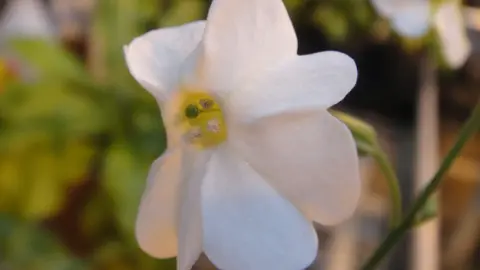Kew Gardens names mysterious plants and fungi new to science
 bartwursten
bartwurstenFrom an underground "forest" to spectacular orchids, scientists at the Royal Botanic Gardens, Kew, discovered 74 new plants and 15 fungi last year.
Many of the mysterious species were found in unlikely places, such as on the top of a volcano or clinging to Antarctic rocks.
The new finds need immediate protection and at least one will probably already have been lost, the scientists say.
About three-quarters of undescribed plants are threatened with extinction.
The top-10 species described as new to science in 2023 are a reminder of the beauty and wonder of the natural world - and a stark warning of the dangers of biodiversity loss and climate change, the researchers say.
 MaartenchristenhuszrRGBKew
MaartenchristenhuszrRGBKewGiving a species a scientific name was the first step towards putting protections in place and investigating potential uses for humanity, senior research leader Dr Martin Cheek said.
"The sheer sense of wonder when you realise that you've found a species that is totally unknown to the rest of the world's scientists and in fact everyone else on the planet, in many cases, is what makes life worth living," he told BBC News.
"It's a huge boost."
Kew's top-10 global discoveries for 2023 include:
Three new species of Antarctic fungi
Antarctica is virtually devoid of flowering plants - but lichens can gain a foothold on small areas of exposed bare rock.
Only 5-10% of all existing fungal species are known - found not just in remote unexplored areas but everywhere on the planet.
 J Etayo
J EtayoAmong this incredible diversity "we are bound to discover new sources of food, medicines and other useful active compounds that can help us find nature-based solutions to some of the biggest challenges we face today," Kew's fungi expert, Dr Raquel Pino-Bodas, said.
An orchid found at the top of a volcano
The plant, with spectacular bright red flowers, was found living on the summit of Mount Nok - an extinct volcano on the Indonesian island of Waigeo.
 Yanuarishaqdwicahyo
YanuarishaqdwicahyoA palm that grows underground
The palm, named Pinanga subterranea, was found on the island of Borneo, in South East Asia.
The bright red fruits and flowers are largely buried underground.
 WilliamJBakerRGBKew
WilliamJBakerRGBKewA possible meat-eating plant from Mozambique
The strange plant (Crepidorhopalon droseroides), from the mint family, attracts and traps insects using sticky hairs - and may digest them for food - but is unrelated to other carnivorous plants.
"I put my money on it being proved as carnivorous scientifically in the next few years," Dr Cheek said.
"And if that is verified, this will be a new occurrence of the evolution of carnivorous plants being recorded."
A pair of trees living almost entirely underground
The trees were discovered growing beneath the Kalahari sands of highland Angola, in central Africa.
Only small parts, such as the flowers, are visible on the surface.
 DavidGoyderRGBKew
DavidGoyderRGBKewOne, known as Baphia arenicola or "growing on sand", belongs to the bean family and has white flowers. The second, Cochlospermum adjanyae, has bright yellow flowers.
"This is such a curiosity for scientists and here are two new species of these very little but very curious underground forests," Dr Cheek said.
A new orchid discovered on the island of Madagascar
The plant has survived thanks to a strange beautiful bird with a blue beak, known as the helmet vanga, which attracts visitors.
Villagers have maintained pockets of forest where the bird lives, in turn safeguarding the habitat of the orchids, which sport pale translucent flowers.
 JohanHermansRGBKew
JohanHermansRGBKewOther discoveries include:
- fungi found growing on food waste in South Korea
- a violet-like flower from Thailand
- an indigo-bearing plant from South Africa
On average, scientists name about 2,500 new species of plants and 2,500 new species of fungi every year - and it is estimated there are as many as 100,000 plants yet to be formally identified.
For fungi, the figure is much higher.
Follow Helen on X @hbriggs.
